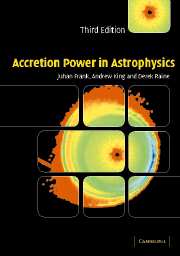Book contents
- Frontmatter
- Contents
- Preface to the first edition
- Preface to the second edition
- Preface to the third edition
- 1 ACCRETION AS A SOURCE OF ENERGY
- 2 GAS DYNAMICS
- 3 PLASMA CONCEPTS
- 4 ACCRETION IN BINARY SYSTEMS
- 5 ACCRETION DISCS
- 6 ACCRETION ON TO A COMPACT OBJECT
- 7 ACTIVE GALACTIC NUCLEI
- 8 ACCRETION DISCS IN ACTIVE GALACTIC NUCLEI
- 9 ACCRETION POWER IN ACTIVE GALACTIC NUCLEI
- 10 THICK DISCS
- 11 ACCRETION FLOWS
- Appendix: Radiation processes
- Problems
- Bibliography
- Index
7 - ACTIVE GALACTIC NUCLEI
Published online by Cambridge University Press: 05 June 2012
- Frontmatter
- Contents
- Preface to the first edition
- Preface to the second edition
- Preface to the third edition
- 1 ACCRETION AS A SOURCE OF ENERGY
- 2 GAS DYNAMICS
- 3 PLASMA CONCEPTS
- 4 ACCRETION IN BINARY SYSTEMS
- 5 ACCRETION DISCS
- 6 ACCRETION ON TO A COMPACT OBJECT
- 7 ACTIVE GALACTIC NUCLEI
- 8 ACCRETION DISCS IN ACTIVE GALACTIC NUCLEI
- 9 ACCRETION POWER IN ACTIVE GALACTIC NUCLEI
- 10 THICK DISCS
- 11 ACCRETION FLOWS
- Appendix: Radiation processes
- Problems
- Bibliography
- Index
Summary
Observations
Accretion on to stellar mass objects occurs in a wide variety of systems and yields a wide variety of observational behaviour. While there may be many arguments over detailed models, the broad basis of these differences is largely understood. Active galactic nuclei also come in many observed forms. From an observational viewpoint, they can be defined as apparently stellar sources but with non-thermal spectra, and, in cases where they can be determined, significant redshifts. Beyond this, we find a wide variety of properties, which we shall classify in more detail below. But in these cases it is not at all clear how these differences arise, or, indeed, whether one is even dealing with variants of a single basic model. We shall argue that the sources are all manifestations of accretion on to supermassive black holes (of order 108M⊙), although even this is still not universally accepted. Furthermore, for stellar-mass objects, at least in some cases, we have a complete picture of the system even if some of the details are missing. In no case do we have anything comparable for active galactic nuclei. That is not to say that there are no aspects of active galactic nuclei that are thought to be fairly well understood, but those that are do not include the mechanism of the basic energy source. Thus we have to try to extract from the available data what clues we can to the nature of the central engine.
- Type
- Chapter
- Information
- Accretion Power in Astrophysics , pp. 213 - 243Publisher: Cambridge University PressPrint publication year: 2002



